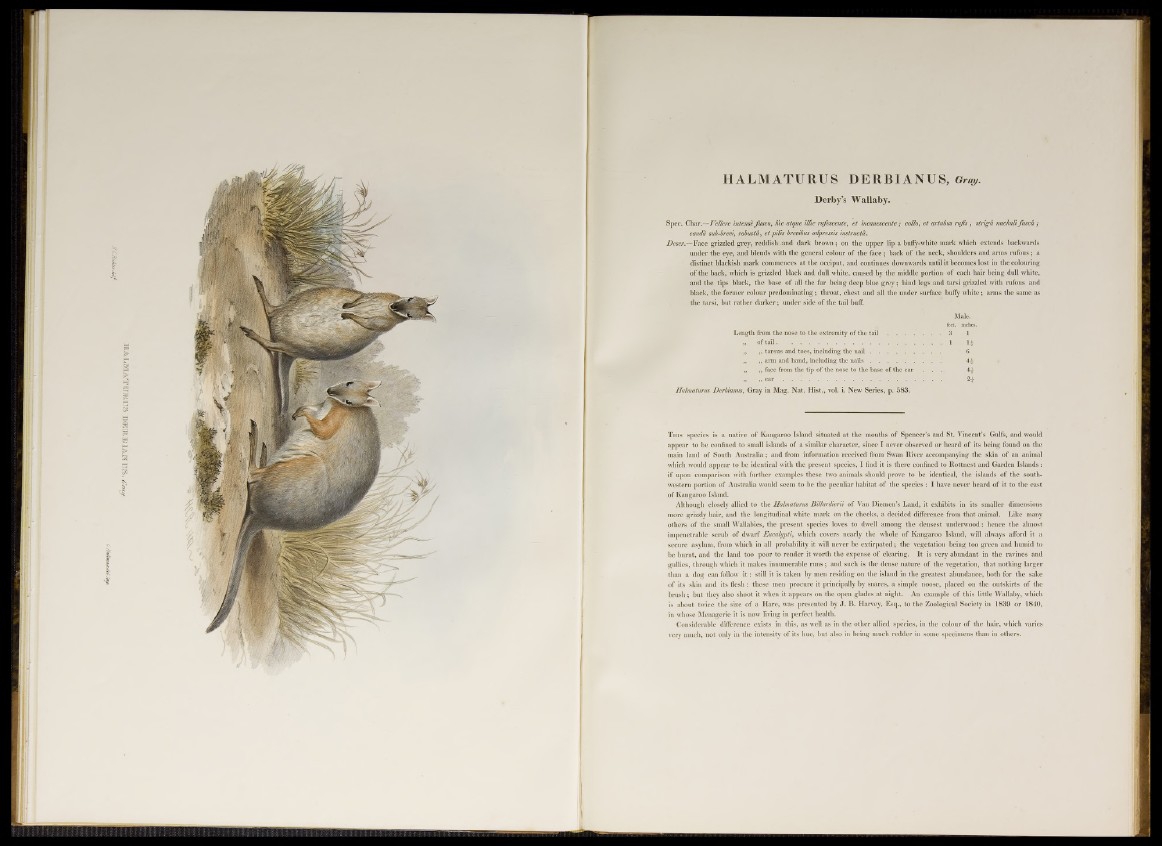
HAJLMA.TtLTB.US DEBBIANIUS. Cray.
HALMATURUS DERBIANUS, Gray.
Derby’s Wallaby.
Spec. Char.—Vellere intense Jusco, Me atque iltic mfescente, et incanescente; collo, et artubus rufis, striga nuchali fusca ;
cauda sub-brevi, robust a, et pilis brevibus adpressis instrue ta.
Descr.—Face grizzled grey, reddish .and dark brown; on the upper lip a bufly-white mark which extends backwards
under the eye, and blends with the general colour o f the face; back o f the neck, shoulders and arms rufous; a
distinct blackish mark commences at the occiput, and continues downwards until it becomes lost in the colouring
o f the back, which is grizzled black and dull white, caused by the middle portion o f each hair being dull white,
and the tips black, the base o f all the fur being deep blue grey; hind legs and tarsi grizzled with rufous and
black, the former colour predominating; throat, chest and all the under surface bufly white; arms the same as
the tarsi, but rather darker; under side o f the tail buff.
Male.
feet, inches.
Length from the nose to the extremity of the t a i l 3 1
„ of ta il............................................................................................................1 $||
„ „ tarsus and toes, including the n a i l ........................................... 6
„ „ arm and hand, including the n a i l s ................................ 4-A-
„ ,, face from the tip of the nose to the base of the ear . . . 4£
,, ,, e a r ......................................................................... ....................... 2^-
Halmaturus Derbianus, Gray in Mag. Nat. Hist., vol. i. New Series, p. 583.
T h i s species is a native o f Kangaroo Island situated at the mouths of Spencer’s and St. Vincent’s Gulfs, and would
appear to be confined to small islands o f a similar character, since I never observed or heard o f its being found on the
main land o f South Australia; and from information received from Swan River accompanying the skin o f an animal
which would appear to be identical with the present species, I find it is there confined to Rottnest and Garden Islands:
if upon comparison with further examples these two animals should prove to be identical, the islands o f the southwestern
portion o f Australia would seem to be the peculiar habitat o f the species : I have never heard o f it to the east
of Kangaroo Island.
Although closely allied to the Halmaturus Billardierii o f Van Diemen’s Land, it exhibits in its smaller dimensions
more grizzly hair, and the longitudinal white mark on the cheeks, a decided difference from that animal. Like many
others o f the small Wallabies, the present species loves to dwell among the densest underwood: hence the almost
impenetrable scrub o f dwarf Eucalypti, which covers nearly the whole o f Kangaroo Island, will always afford it a
secure asylum, from which in all probability it will never be extirpated; the vegetation being too green and humid to
be burnt, and the land too poor to render it worth the expense o f clearing. It is very abundant in the ravines and
gullies, through which it makes innumerable runs; and such is the dense nature o f the vegetation, that nothing larger
than a dog can follow i t : still it is taken by men residing on the island in the greatest abundance, both for the sake
o f its skin and its flesh: these men procure it principally by snares, a simple noose, placed on the outskirts o f the
brush; but they also shoot it when it appears on the open glades at night. An example o f this little Wallaby, which
is about twice the size o f a Hare, was presented by J. B. Harvey, Esq., to the Zoological Society in 1839 or 1840,
in whose Menagerie it is now living in perfect health.
Considerable difference exists in this, as well as in the other allied species, in the colour of the hair, which varies
very much, not only in the intensity o f its hue, but also in being much redder in some specimens than in others.